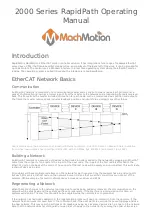
Asycube - Asyril SA
Programming Guide
©
Copyright Asyril S.A.
000.101.572
Version : A1
55/83
6.
Modbus TCP
From firmware version 4.0.0, the Asycube offers a Modbus TCP slave (=server) interface in
order to simplify the integration with PLCs and other Modbus TCP masters (=clients) over
TCP/IP networks. More information on Modbus can be found in the protocol specification
available on
The Section 6.1 presents all necessary information to communicate with the Asycube through
Modbus TCP. The Section 6.2 shows typical performances that can be achieved. The
Asycube Modbus Register Table is presented in Section 6.3. The Section 6.4 explains the
different types of errors and the way to handle them. Finally, the Section 6.5 gives a few
useful examples, such as how to start a platform vibration through Modbus TCP.
6.1.
Configuration
Default Modbus TCP parameters for the Asycube are:
The IP Address and the Subnet Mask are shared with the Ethernet communication
(Section5.1) and can be changed in the configuration page of the Asyril HMI unlike the
Modbus port, which is fixed to 502.
Out of all Modbus public function codes, the Asycube implements the minimum useful set of
functions (Class 0):
Code 03 (0x03): Read Holding Registers, with 16 bits access
Code 16 (0x10): Write Multiple Registers, with 16 bits access
6.2.
Performance
This section presents the performance and limitations of the Asycube Modbus TCP
implementation.
6.2.1. Communication
The Asycube only accepts one Modbus master/client to be connected at a time. However, a
TCP/IP connection (See Chapter 5) can be used in parallel with Modbus; this can be useful to
IP Address
192.168.127.254
Subnet Mask
255.255.255.0
Modbus port
Unit ID
502
N/A for Modbus TCP
















































